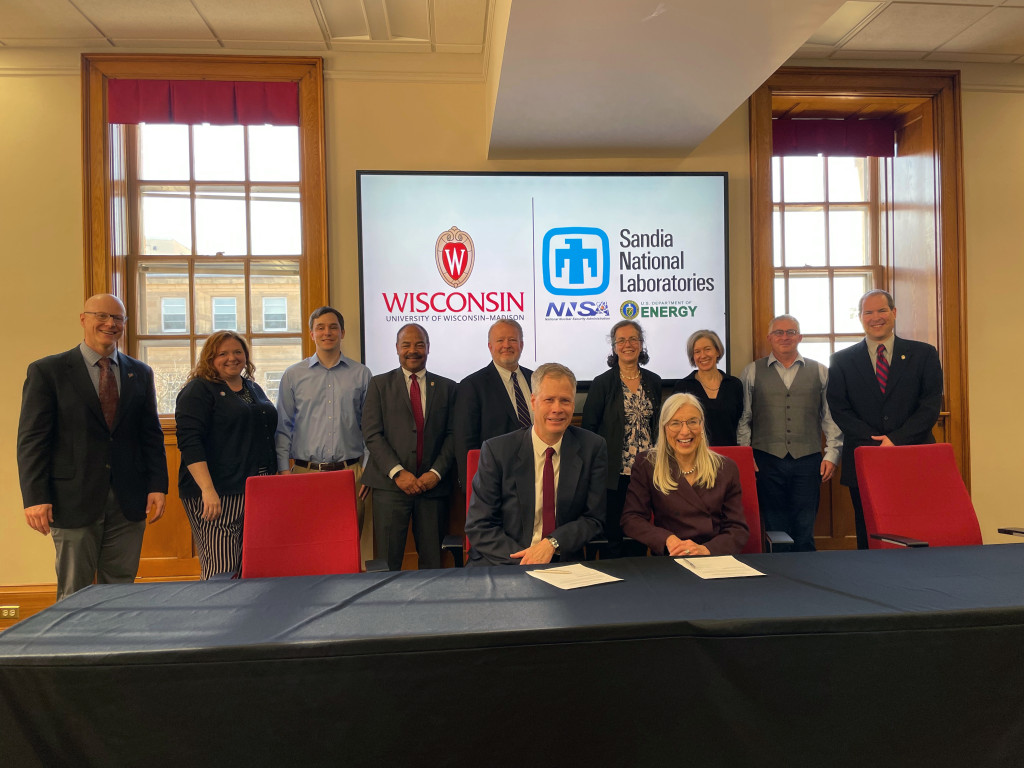UW–Madison and Sandia National Laboratories expand strategic partnership

Rob Leland, Director of the Climate Change Security Center at Sandia National Laboratories, and Cynthia Czajkowski, Interim Vice Chancellor for Research at UW–Madison, surrounded by leadership from the College of Letters & Science, the College of Engineering, and the College of Agricultural & Life Sciences, celebrate the signing of a memorandum of understanding (MOU) between the two institutions.
At a ceremony earlier this month in Bascom Hall, research leadership from the University of Wisconsin–Madison and Sandia National Laboratories, the largest of the Department of Energy National Laboratories, celebrated the signing of a memorandum of understanding (MOU) between the two institutions for a strategic partnership to sustain the future of science and engineering for national security.
UW–Madison’s science and engineering capabilities and history of partnerships make it a principal research center for topics of national security importance, such as quantum science and climate change.
“This MOU really cements the strategic partnership between Sandia National Laboratories and UW–Madison, and opens the door to further collaboration between these two research powerhouses,” said Cynthia Czajkowski, UW–Madison’s Interim Vice Chancellor for Research (VCR). “UW–Madison is known for innovating for the public good, which is the Wisconsin Idea. We really are trying to build solutions for societal challenges at the forefront of innovation. This strategic partnership is built with that spirit of collaboration for us towards this common goal of finding solutions for societal problems.”
“Sandia wants to expand our relationships with the great public research universities, and I am delighted to be a part of the effort here at the University of Wisconsin–Madison,” said Rob Leland, Director of Sandia’s Climate Change Security Center. “We’re also delighted because of the incredible breadth and depth in STEM fields that Wisconsin brings to the table. And that gives us a lot of possible touchpoints and connections and things to work with. This is something that Sandia values quite strongly and we’re here for the long term.”
The MOU supports collaboration between Sandia research staff and UW–Madison faculty, staff, and students to support complementary institutional goals, and supports projects and access to funding sources not normally available to either institution alone. The partnership also supports unique opportunities for internships for students at both the undergraduate and graduate levels, as well as postdoctoral research. Under the agreement, UW–Madison and Sandia may also share personnel, expertise, capabilities, and infrastructure in areas of common strategic interest.
According to the MOU, the drivers for this agreement are the evolving makeup of the national research landscape; the complex nature of the problems that are important to the economy and security of the nation; the challenge of attracting, growing, and retaining a sufficient base of qualified researchers; the availability and mechanisms for funding to solve these big problems; and the benefits of collaboratively creating and disseminating new ideas and technologies for the public good.
During their three-day visit to campus, Leland; UW alum Erik Webb, campus executive for the Sandia/UW–Madison partnership; and Nicole Streu, Sandia’s senior technical recruiter, met with researchers from the College of Letters & Science (L&S), the College of Engineering, the College of Agricultural & Life Sciences (CALS), and several research institutes and centers around campus, to learn more about how UW–Madison’s areas of expertise align with Sandia’s own diverse research priorities.
Research areas and labs reviewed by Sandia included Physics, the Wisconsin Quantum Institute, Computer Sciences, Statistics, Botany, Geoscience, Atmospheric and Oceanic Sciences, the Space Science and Engineering Center (SSEC), multiple fusion and clean energy initiatives led by Engineering, the Clean Energy Community Initiative, the Wisconsin Electric Machines and Power Electronics Consortium (WEMPEC), the Wisconsin Energy Institute (WEI) and Great Lakes Bioenergy Research Center (GLBRC), the Cryo-Electron Microscopy Research Center (CEMRC), and the Midwest Center of Excellence for Vector-borne Disease. It was all topped off with ice cream from the Babcock Dairy Plant.
“We are deeply impressed with the University of Wisconsin–Madison’s depth and breadth of science, engineering, and social and policy efforts focused on the global climate challenge as well as the cutting edge and truly unique experimental facilities we saw,” said Webb. “This relationship is of great importance to Sandia National Laboratories, and we are committed to a long, productive, and nationally impactful relationship.”
Sandia National Laboratories is a multimission federal laboratory with an annual budget of $4.8 billion operated by National Technology and Engineering Solutions of Sandia, LLC, a wholly owned subsidiary of Honeywell International, Inc., for the U.S. Department of Energy’s National Nuclear Security Administration (NNSA). Sandia Labs has major research and development responsibilities in nuclear deterrence, global security, defense, energy technologies, and economic competitiveness, with main facilities in Albuquerque, New Mexico, and Livermore, California.
Tags: federal relations
